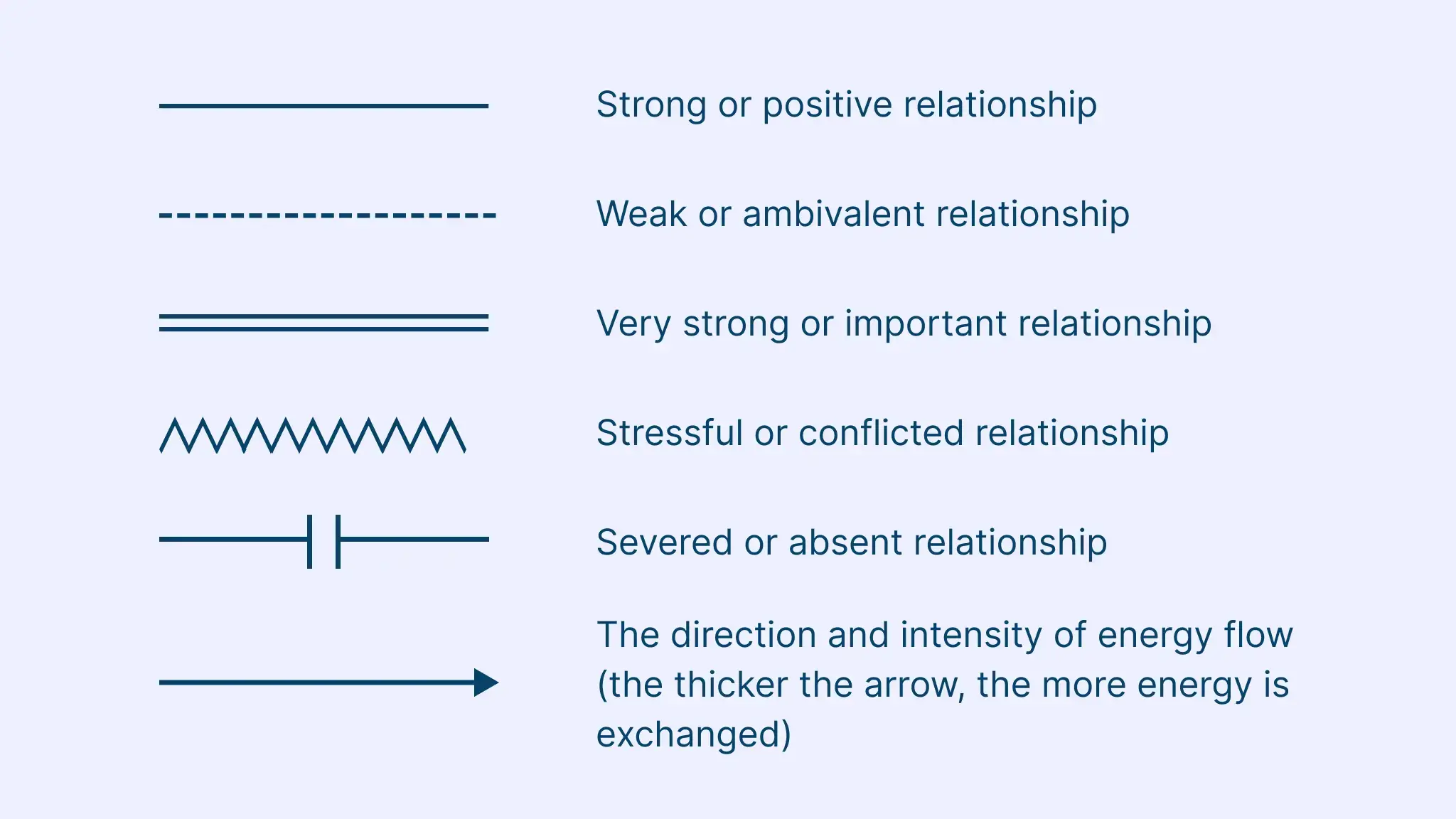In this blog post, we will explain what ecomaps are, how to create them, and why they are useful for various professionals. We will also share some examples of ecomaps and how they can be used in different situations. By the end of this post, you will have a clear understanding of ecomaps and how to apply them in your practice.
- What is an Ecomap?
- Ecomap Symbols
- Differences Between an Ecomap and a Genogram
- Advantages of Using Ecomaps
- Exploring Common Use Cases With Ecomap Examples
- Crafting Your Ecomap with Creately
- Wrapping Up: The Impact of Ecomaps on Personal and Professional Growth
What is an Ecomap?
An ecomap is a visual diagram that shows the personal and social relationships between a person or a family and their surroundings. They graphically represent various systems an individual interacts with, and the nature of these interactions. Dr Ann Hartmann developed ecomaps in the 1970s as a way to show the interactions between a client and their environment. They can help you identify the sources of support and stress in your clients' lives, as well as the gaps and opportunities for intervention.
Typically, an ecomap shows the following information:
The client or the family unit (represented by a circle in the center of the diagram).
The significant people, groups, organizations, or institutions in the client’s life (represented by circles or squares around the client).
The nature and quality of the relationships between the client and these entities (represented by different types of lines and symbols).
The energy flow between the client and these entities (represented by arrows).
Ecomap Symbols

Differences Between an Ecomap and a Genogram
| Aspect | Ecomaps | Genograms |
|---|---|---|
| Focus |
|
|
| Content |
|
|
| Representation of Relationships |
|
|
| Dynamic Nature |
|
|
| Purpose |
|
|
| Visual Elements |
|
|
Advantages of Using Ecomaps
Ecomaps can provide several benefits for both clients and professionals, such as:
Helping clients gain insight into their own situation and see how their environment affects them.
Assisting professionals understand their clients better and tailor their interventions accordingly.
Facilitating communication and collaboration between clients and professionals, as well as among different service providers.
Highlighting the strengths and resources of clients and their networks, as well as the areas of need and improvement.
Monitoring the changes and progress of clients over time.
Exploring Common Use Cases With Ecomap Examples
Ecomaps can be used by various professionals who work with individuals, families, groups, or communities. Here are some examples of how ecomaps can be applied in different fields:
Social work: Ecomaps can help social workers assess their clients' social functioning and identify their needs, goals, and resources. They can also help social workers plan and evaluate their interventions and coordinate with other agencies.
Counseling: Ecomaps can help counselors explore their clients' emotional issues and how they relate to their environment. They can also help counselors develop therapeutic strategies and enhance their rapport with their clients.
Education: Ecomaps can help educators understand their students' backgrounds and learning styles. They can help teachers understand the support systems available to a student, including family, friends, and community resources. By visualizing the student’s environment, educators can identify potential challenges or stressors that may impact learning, such as financial instability or health issues. Accordingly, ecomaps can help educators design curricula and activities that suit their students' needs and interests.
Crafting Your Ecomap with Creately
Creately is an intuitive diagramming and visual collaboration platform which you can use to create ecomaps. Here’s how to use it:
Start by selecting a template from the template section. Use the search function to quickly find specific ecomap templates. You can also opt to create one from scratch, using the dedicated genogram shape library.
Once you’ve selected a template, you can customize it by adding or removing elements, changing colours or styling. With the infinite canvas, you are able to expand your ecomap easily and illustrate any amount of information.
You can add additional information as notes, links, docs and attachments via the notes panel.
Creately is effective for team collaboration. Share your ecomap with colleagues in real-time. Everyone can contribute simultaneously, ensuring a thorough and collective understanding of the ecomap’s insights.
Export your ecomaps in PNG, JPEG, PDF and SVG formats or embed in site.
Integrating cloud storage in platforms like Creately improves the utility of ecomaps by making them easily accessible and collaborative. This means that healthcare professionals, patients, and support networks can work together seamlessly, regardless of location, to create and update ecomaps in real-time.
Wrapping Up: The Impact of Ecomaps on Personal and Professional Growth
Ecomaps serve as a visual bridge that connects the dots within social ecosystems to promote a deeper understanding of individual and group dynamics. By using ecomaps, professionals across various fields can benefit from:
- Personalized insights: With the ability to customize templates, each ecomap becomes a tailored tool that reflects the unique context of the individual or group.
- Enhanced communication: Visual representations allow for clearer discussions and more effective problem-solving. Preventative care: Ecomaps can highlight potential health risks, leading to early intervention and better health outcomes.
- We hope this blog post has given you a comprehensive overview of ecomaps and how to use them in your practice. If you have any questions or comments, feel free to leave them below. We would love to hear from you!






